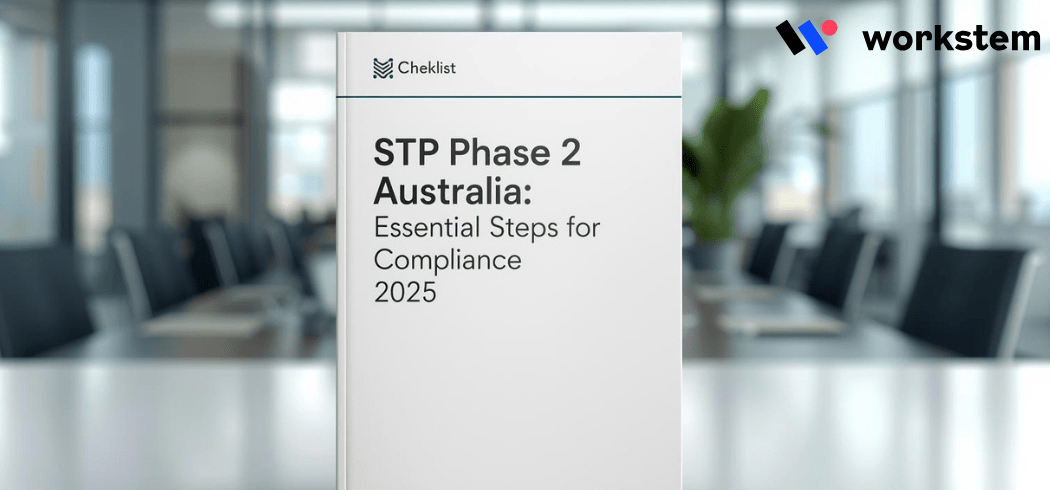The transition to Single Touch Payroll (STP) Phase 2 is a significant update for Australian businesses, requiring more detailed payroll reporting to the ATO. While the deadline for most businesses has passed, ensuring ongoing compliance and a correctly executed migration is crucial. This comprehensive checklist and guide will help you verify your setup, avoid penalties, and streamline your payroll processes.
Why STP Phase 2 Matters
STP Phase 2 expands the data you report to the ATO, aiming to reduce the reporting burden for employers interacting with multiple government agencies and provide Services Australia with more accurate and timely information for social security benefits. Getting it right is essential for compliance and smooth business operations.
Complete STP Phase 2 Preparation Checklist (15 Essential Steps)
Follow this step-by-step checklist to ensure your business is fully compliant.
- Confirm Your STP Phase 2 Registration: Verify with your tax professional that your business is correctly registered for Phase 2 with the ATO.
- Employee Data Verification: Audit and clean your employee records. Ensure full names, TFNs, dates of birth, and address details are accurate.
- Categorise Employees Correctly: Accurately assign each employee an income type (e.g., salary & wages, working holiday maker, closely held payee) and tax scale.
- Update Pay Codes: Align your pay codes (e.g., overtime, allowances, leave) with the new ATO reporting categories.
- Map Allowances and Bonuses: Classify each allowance and bonus correctly according to the ATO’s specific definitions.
- Classify Lump Sum Payments: Identify and correctly report any eligible lump sum payments (E, L, or M).
- Review Salary Sacrifice Arrangements: Ensure these are reported correctly in the pre-tax section of your payroll reports.
- Check Termination Reason Codes: Have the correct ATO-defined reason codes ready for any employment terminations.
- Assess Your Payroll System: Contact your software provider to confirm it is an ATO-approved STP Phase 2 solution.
- Train Your Payroll Team: Ensure staff understand the new data fields and reporting requirements.
- Perform a Test Submission: If possible, run a test pay event and review the output file before sending live data to the ATO.
- Review ATO Finalisation Steps: Understand the process for finalising your payroll data at the end of the financial year.
- Backup Your Data: Complete a full backup of your payroll data before making any significant changes.
- Communicate with Employees: Inform your staff about what STP Phase 2 means for their income statements and payslips.
- Schedule a Go-Live Date: Plan your first official STP Phase 2 pay run and monitor the submission for errors.
Pre-Migration Requirements: What You Need Before Starting
Before you begin the technical process, ensure you have these foundations in place:
- Software Compatibility: This is the most critical step. Your payroll software must be updated to an ATO-approved version that supports STP Phase 2. Do not attempt to proceed without this.
- Comprehensive Employee Records Audit: Inaccurate data is the primary cause of reporting errors. Dedicate time to reviewing every employee file for completeness and correctness.
- Robust Backup Procedures: Always create a verified backup of your company and employee data before you start the migration process within your software. This allows for a restore if anything goes wrong.
Implementation Timeline: A Structured 4-Week Action Plan
If you are finalising your migration, this structured plan can help.
Week 1: Discovery & Planning
- Contact your software provider (e.g., Workstem) for Phase 2 resources.
- Form an internal project team.
- Start your employee data audit.
Week 2: System Configuration
- Update your payroll software to the latest version.
- Begin re-mapping pay categories and income types within your system settings.
- Conduct initial staff training on the new requirements.
Week 3: Testing & Validation
- Process a test pay run for a small group of employees.
- Review the generated STP file to ensure data is categorised correctly.
- Correct any mapping errors identified during testing.
Week 4: Go-Live & Review
- Process your first live pay run using STP Phase 2.
- Monitor the ATO submission for any immediate errors or warnings.
- Review the first successful submission and confirm with your bookkeeper or tax agent.
Common STP Phase 2 Preparation Mistakes to Avoid
Learn from the mistakes of others to ensure a smooth transition:
- Assuming Software is Auto-Updated: Even cloud software may require you to manually enable STP Phase 2 features within the platform.
- Incorrect Income Type Mapping: Misclassifying employees (e.g., a contractor as an employee) leads to ATO discrepancies.
- Overlooking Historical Data: While Phase 2 reports current data, your system must handle year-to-date figures correctly after the transition.
- Ignoring ATO Warning Messages: Address any errors or warnings from the ATO immediately to avoid compliance issues.
- Failing to Communicate: Not informing employees about changes to their payslip presentation can lead to unnecessary queries.
How Workstem Helps Manage STP Obligations?
Ensure your business remains compliant effortlessly. Let Workstem’s automated payroll and integrated STP Phase 2 reporting handle the complexity for you. Explore Workstem’s STP Solution today and ensure peace of mind with every pay run.
Simplify award interpretation and payroll processing with Workstem, the all-in-one workforce management & payroll software designed for every industry.Workstem is an ATO-approved STP Phase 2 solution that simplifies compliance by automating the entire process:
- Built-in Validation: Workstem’s software is designed with the correct STP Phase 2 fields and categories, guiding you to enter data correctly and reducing errors.
- Seamless Integration: As an all-in-one platform, Workstem integrates time & attendance, payroll, and STP reporting. This eliminates manual data entry between systems, ensuring the data you report is accurate and consistent.
- Easy Submissions: Reporting is done with a single click at the end of each pay run, with immediate confirmation from the ATO.
- Simplified Finalisation: The year-end finalisation process is streamlined and can be completed in minutes.
Choose from our Standard or Advanced plan to suit your business needs, and stay Fair Work compliant with confidence.
FAQs About the Single Touch Payroll (STP)
Q1: What is Single Touch Payroll (STP) in simple terms?
A: Single Touch Payroll (STP) is a mandatory Australian government initiative that requires businesses to report their employees’ payroll information—such as salaries, wages, pay-as-you-go (PAYG) withholding, and superannuation—to the Australian Taxation Office (ATO) directly from their payroll software each time they run payroll. It’s “single touch” because the reporting happens with a single action at the same time as you pay your staff.
Q2: Who needs to report through STP?
A: Essentially, all Australian employers must report through STP.If you have even one employee, you are generally required to use STP.
Q3: What is the difference between STP Phase 1 and STP Phase 2?
A: STP Phase 2 expands the reporting requirements introduced in Phase 1. The key difference is the level of detail provided to the ATO.
- STP Phase 1 reported total amounts for key figures like gross earnings and tax withheld.
- STP Phase 2 requires a detailed, disaggregated breakdown of an employee’s income (e.g., separating salary, overtime, allowances, and leave payments).
Q4: What are my ongoing STP reporting obligations?
A: Your main ongoing obligations are:
- Report Each Pay Event: Submit the required data to the ATO on or before every pay day.
- Year-End Finalisation: Finalise your data by 14 July each year. This declares the information for the financial year is complete and correct. This replaces the need to provide payment summaries to your employees.
- Keep Records Accurate: Ensure employee details in your payroll software are always up-to-date (e.g., tax declarations, super fund choice).
Q5: I missed the STP Phase 2 migration deadline. What should I do?
A: You should take action immediately:
- Contact your software provider to start the transition process.
- Lodge a voluntary disclosure with the ATO to explain the delay. The ATO generally looks favorably upon businesses that come forward voluntarily and may provide you with a compliance plan or extra time to transition.
- Ensure you are using an ATO-approved STP Phase 2 solution, like Workstem, to become compliant.
Q6: How does STP help with my employees’ Superannuation?
A: While STP itself does not pay your super, it reports the liability for superannuation to the ATO each payday. This allows the ATO to better monitor and ensure that employers are meeting their super guarantee obligations on time. You still need to pay your super contributions to your employees’ funds by the quarterly due dates.
Q7: Does STP change when I have to pay my tax and super?
A: No. STP is a reporting system, not a payment system. The due dates for paying the PAYG withholding tax you report to the ATO and your super guarantee contributions to funds remain unchanged.
Q8: What happens if I make a mistake in my STP report?
A: Mistakes can be fixed. If you discover an error in a past submission, you can make a STP amendment through your payroll software. You simply correct the information in your system and submit a revised update to the ATO. It’s important to correct errors as soon as you find
Q9: Where can I find official information from the ATO?
A9: The best source of truth is always the official ATO website. You can find comprehensive guides, news, and resources on their Single Touch Payroll for employers page.
Book a free demo with our payroll experts and experience how Workstem can streamline your payroll and workforce operations.
Read More:
STP Phase 2 Australia: Post-Migration Compliance Guide & Requirements
Single Touch Payroll 2025: Everything Australian Employers Need to Know
Avoiding STP Penalties 2025: ATO Audit Guide & Risk Prevention
Guide to Single Touch Payroll for Closely Held Payees
Guide to Single Touch Payroll Phase 2
Guide To Single Touch Payroll (STP)








